splines in space
theorising through (dance) practice
Keyboard Practice
published 31 January 2006 by mpgough.I'm an unreliable narrator. Everything I know about classical piano could be stored handily, uncompressed, in the lobotomized set-top box of an antique cathode television. Still, it falls to me to transcribe the events surrounding the Van Meegeren Piano Competition of 2023 and the alleged visitation by the late Stefan Janacek.J G McDaid
you can read the online text at The Magazine of Fantasy & Science Fiction here; Keyboard Practice, consisting of an aria with diverse variations for the harpsichord with two manuals. Or you can listen (2 hours) to a reading; 60 Mb mp3 / torrent.
excellent
via: boingboing
mocap notes ii
published by mpgough.just a few links to motion tracking systems
- Animazoo; gyroscopic
- Ascension Technology Corporation; MotionStar Wireless 2 (magnetic), ReActor 2 (optical - active).
- Measurand; ShapeWrap II (fibre optic)
- Motion Analysis Corporation; Eagle-4 Digital (optical - passive)
- Phasespace; Impulse (optical - active).
- PhoeniX Technologies; Visualeyez (optical - active).
- Polhemus; Liberty (magnetic).
- Simi Reality Motion Systems; Simi MotionCap 3D (optical - passive), Simi MatchiX (optical - markerless).
- Vicon Peak; Vicon MX (optical - passive).
Maureen Furniss has written a good overview of motion capture.
Nam June Paik (1932 - 2006)
published 30 January 2006 by mpgough.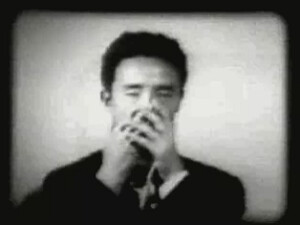
Nam June Paik 1932 - 2006
Paik studios
woof (wú - mu)
published 29 January 2006 by mpgough.元日やさらに旅宿とおもほへず
ganjitsu ya sara ni ryoshuku to omohoezu
New Year's Day --
that I'm still on this journey
unbelievable
Kobayashi Issa 1795
ramen recital
published 27 January 2006 by mpgough.some more notes on motion capture (mocap) [1], but first a few points;
- the traces are the 'raw' data from which i generate my transcriptions, i believe motion capture is the fastest way to get somatically accurate transcriptions.
- until i resolve the hand marker issue to an acceptable lvel of tracking (i.e. accurate and consistent) i'm usually tracking the palm, and sometime the thumb and index finger (metacarpless & phalanges).
- i use the traces in two distinct ways, a) as the initial stage of my transcriptions, and b) as choreographic scribbles.
ever since my early research into choreographic 'scribbles' i've had a renewed interest in drawing. clearly the concept of (dance) movement as a precursor to drawing is not new, nor is my usage particularly novel ... but i think it's important to our practice.
i tend not to use a full maker set when drawing my dances, i want a more refined noodle soup than everything in the cupboard. the particular combination and placement of makers will depend on my research (practice, task, development) goals. for example if was looking at diagonal - bilateral connectivity i might use a set of markers from the left foot to the right hand. i could then see the paths (shapes) that individual segments and connected whole took.
often i just want some interpretive documentation (so i can see at a glance how i'm using space / time) so i'll use a small set of offest markers (not located on skeletal landmarks) in distributed pattern. a set of eleven offset markers produce a scriible like this;
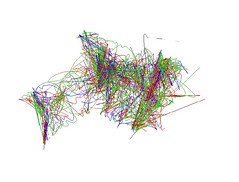
or you can just look at a single marker;
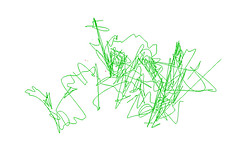
i can review these scribbles in two, three and four dimensions, with minimal practice you get deeper understanding of your movements cartography, allowing you to evaluate and refine these aspects almost immediately.
it's also possible to play around with the structures you see on the screen. normally what you look at is a set of links that approximate the human body. these links are derived from the markers and are customised by the user to suit their particular needs. often the markers are linked (virtually) to assist the template system the mocap software uses to identify the markers (by assessing the spatial relationship of the passive markers). this is how they look on the screen;
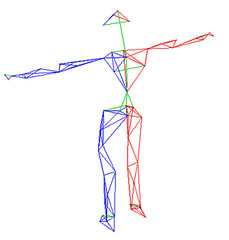
and here i have drawn the links onto a photo (of my back) to show how they relate to the physical markers / body;
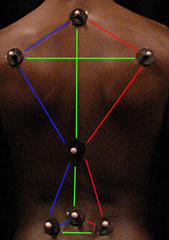
when tracking the makers the software determines how much the links may 'stretch' before it breaks them. if we randomly lik the offset markers in differing patterns the software makes and breaks links dynamically, the effect is a kaleidoscope of geometric shapes. we can use the changing shapes as a tool to create more material, or to evaluate how often we repeat similar poses. i should also make it clear that the dancer (often me) does not look at the display screen whilst dancing
if you wanted to play with tools to turn motion into drawing there are a few applications you could adapt to your needs;
- optica [195kb zip windows XP] by panajotis mihalatos.
- flyt dig by ole kristensen (optica inspired)
i have other high and low tech methods of creating noodles (3d choreographic scribbles) but i save those for another time ...
[1] Motion capture is really motion tracking i'll talk about this more in forthcoming posts
noodle dance
published 24 January 2006 by mpgough.there are several different types of motion tracking technology; Magnetic, Gyroscopic and Optical (passive or active). My personal preference would be for high resolution, small sensor gyroscopic system that would allow me to track position and orientation of small bones such as the phalanges. At the moment i'm using a passive optical system with markers like this;
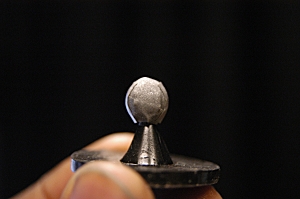
However, i really need to track the fingers for my motion transcriptions but optical marker miss-identification resulting from marker occlusion makes this difficult. For example, when fingers and thumb touch all makers can be seen;
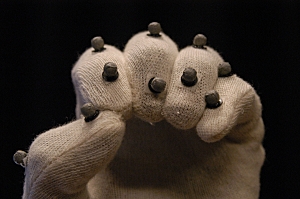
clench the fist and markers are occluded (hidden);
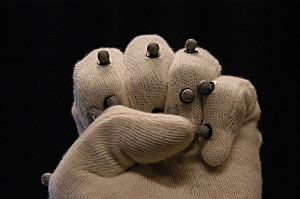
as the tracking is passive the system does not always map the markers correctly when the reappear. With an active optical system (LED's instead of retroreflective markers) each marker is uniquely identified partially resolving this problem. However, given the large number of markers i want to use (100 +) an active system is not practical (identifying all the makers would cause the system to 'lag' behind 'real-time' tracking). SIMM solving in real-time already causes me problems as the live representation is slightly behind the action, but i can turn this solving off and post-process solve from the same data. With active tracking i would be forced to work through the system lag.
i'm also having issues with the EVaRT software, which makes it clear to me how far current technology is from satisfying our needs for accurate, simple dance documentation. i have a movement phrase (improv) that is 01.41 minutes long at 200 Hz (20305 frames) with 61 markers. Even with a four processor machine editing (system processing not the edit tasks themselves) take an age. The page file balloons [screen shot]until the application grinds to a halt and i have to shut it down and restart. the only solution seems to be a) turn off the undo buffer, or b) save after each edit and clear the undo buffer; neither option makes for a fast work flow.
Fortunately SIMM solving in post process mode (to generate the HTR data) is not quite so slow, the 1:41 minute clip mentioned in the previous paragraph takes around 02:25 minutes to solve. and if you were wondering what the motion paths look like for that clip ... welcome to the noodle dance;
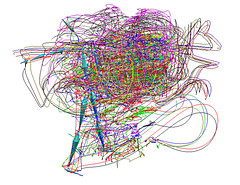
motion capture (dance)
published 23 January 2006 by mpgough.the basic marker set i'm using has 61 (passive) markers [marker set front & back] tracked using a Motion Analysis system.
The image below shows the paths (coloured lines) of the markers and a htr skeleton[Lulewicz] derived from SIMM (Software for Interactive Musculoskeletal Modeling)[Neuromuscular Biomechanics Lab] solving within the Motion Analysis software[ma-simm].
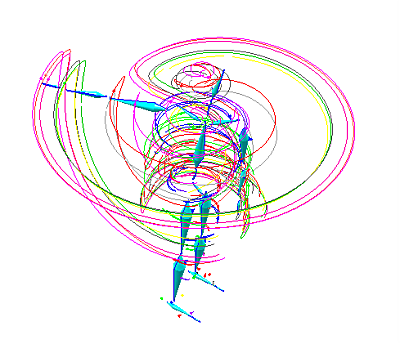
The movement is a torso spiral with an extended right arm. An eight camera setup was used to tracked the motion at 200 Hz, marker noise was cleaned using a 20 Hz Butterworth filter[Wikipedia].
dance podcast
published 20 January 2006 by mpgough.Doug Fox [Great Dance Weblog] has started a dance podcast, roll on over to his site for more info or use this link; Great dance podcast (requires itunes). It's great that doug has started this of and i feel privileged to have been the first interview.
i'll post some notes about issues discussed in the interview after the weekend.
lunacy nicked
published 15 January 2006 by mpgough.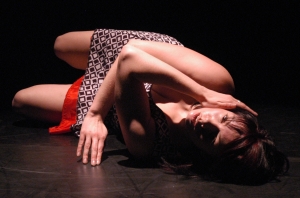
Lunacy Nicked strikes the balance between playfulness and sentimentality in the non-stop Hear Me In. The audience are thrown into a game-show like atmosphere right from the start thanks to the recorded voices. The dance is artistically energetic, utilizing the entire stage. The performance leads us down lots of blind alleys, with an exaggerated narrative leaving us with much to guess at. The high kicks and leg gestures thrown by the three female dancers in their dresses have echoes of Busby Berkeley and the can-can. The exploration of relationships through archetypal movement challenges the original momentum of the dance to create a captivating tenderness. [Laura Griffiths]
a few shots from Ear Me In (2006) by Lunacy Nicked , performed as part of Resolution! 2006. photos by me.
new year - new sharing
published 03 January 2006 by mpgough.happy new year!
some food for thought ...
All we want to do is dance. But if we continue to work in isolation from each other and from practitioners in other forms, if we continue to pursue personal ambitions without recognizing the value of contributing to the whole and sharing resources, if we do not proactively rethink the framework that favors the success of individual, and most importantly if we do not understand what it is contemporary dance has to offer the wider community then we will not reach critical mass.
recent posts
archives
newsfeed
blogroll
- ArtsJournal (dance)
- Break-A-Leg
- DA ... NCE
- Dancehunter
- david-o.net
- Downtown Dancer
- Great Dance Weblog
- Leigh Witchel
- motive (reason to move)
- Newness Dance
- Onward and Upward
- Rachel Howard.com
- Sort of a weblog
- thewinger
- uncoy.com | la vie viennoise
- We All Dance
- 3hive
- Archinect.com
- Cat and Girl
- Drawn! The Illustration Blog
- media art net
- networked performance
- PostSecret
- we make money not art
- usergland